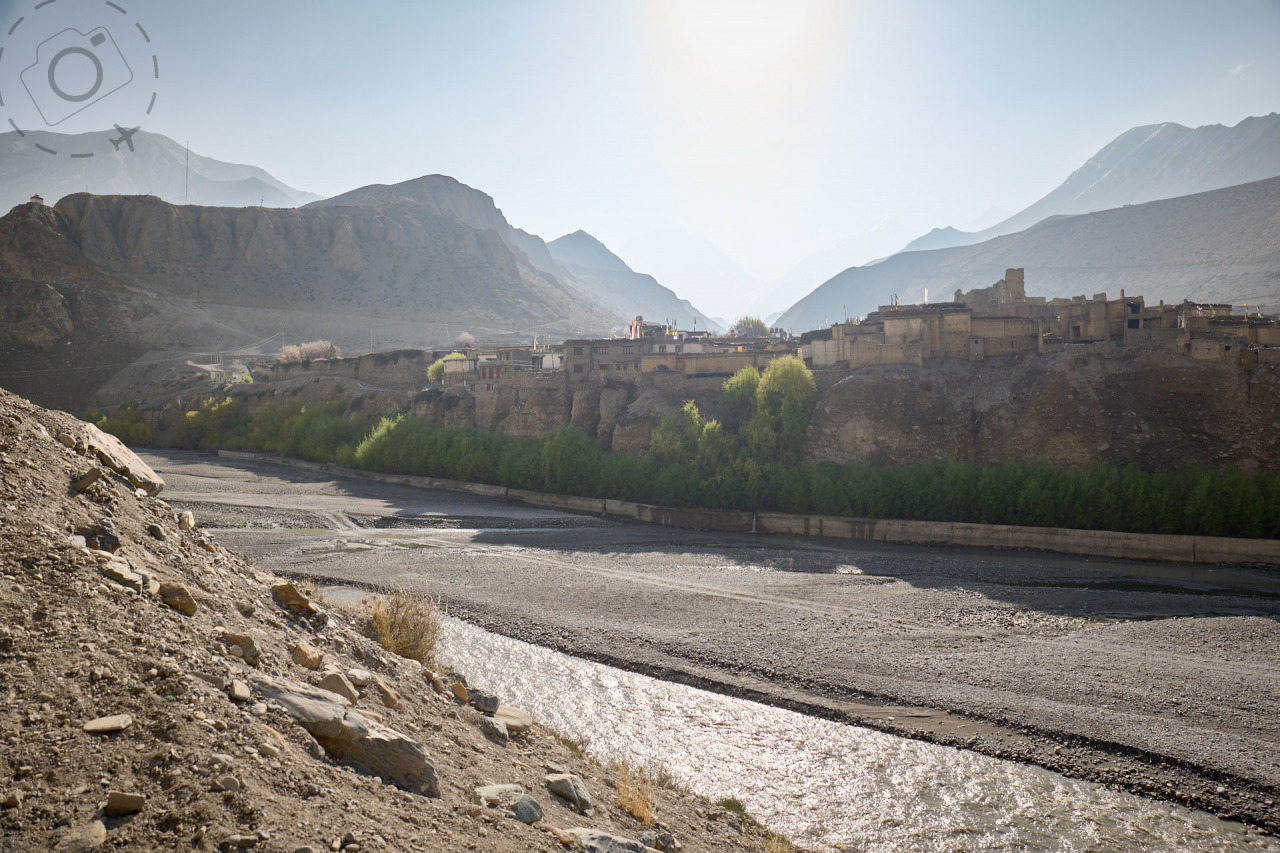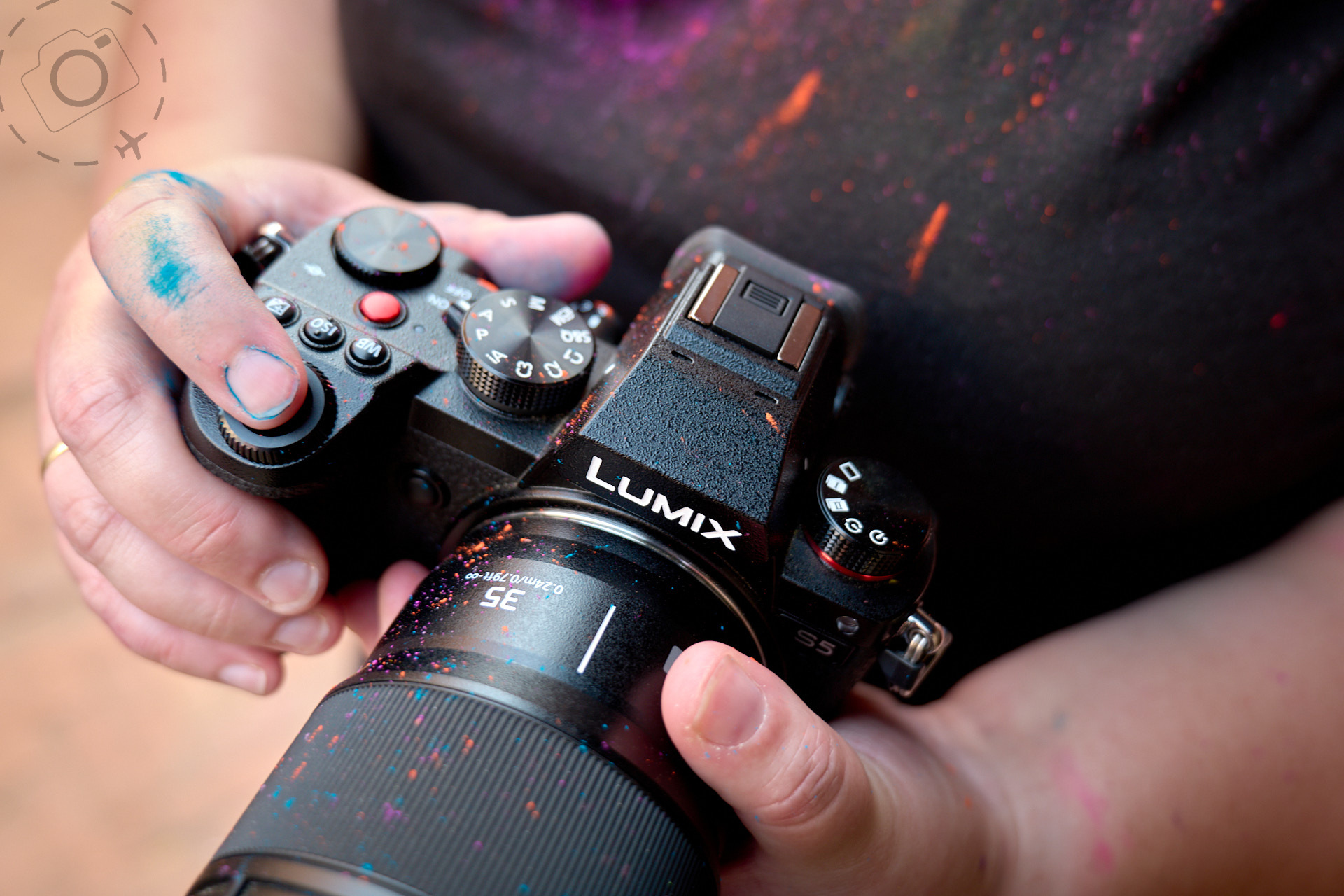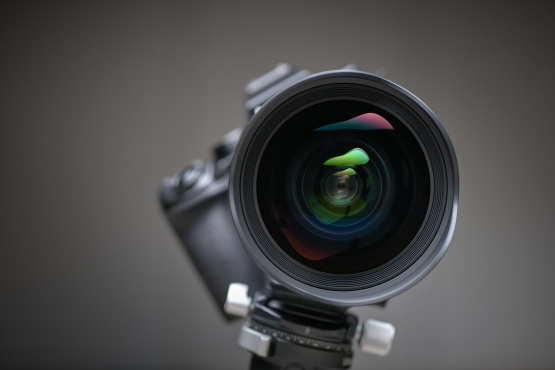What’s on offer with the LUMIX S5 and their new prime lens range is unlike anything else I’ve worked with in the full-frame market. Seriously powerful video and stills capabilities, in a seriously small and light form factor. The camera body is excellent, but it’s the light-weight prime lenses which take the system to the next level. These very compact lenses have a consistent thread diameter, nearly identical size and weight, plus deliver an appealing range of focal lengths with superb optics.

? Pilgrims by the Kali Gandaki
FULL FRAME ROAD TEST
We’ve just come back from a month in Nepal, reconnecting with our ground crew over there and running a new tour concept. It’s the first international trip we’ve run since covid stopped the world in March 2020. For us it was a big deal to get back on the horse again, but also an important opportunity to collect video and stills to promote the new tours in years to come. Leading a tour while shooting content is always hard work, so it really helps to travel light.
Last time I was in Nepal I carried a pair of LUMIX G9’s with me, and fell in love with the 10-25mm f/1.7. It was the first wide-angle zoom I’ve ever been happy with, and was also my first experience concentrating on video for a few weeks. I shot everything at 180fps (FHD) and found my groove a little in the world of video.
This time everything was new. Full frame LUMIX S5 bodies instead of the MFT sensor in the G9. I was packing a series of nifty little f/1.8 primes instead of the one-stop-shop of the 10-25mm f/1.7 (20-50mm equivalent). While I’ve enjoyed working with the S1R and S1H for my professional work over the past few years, this was my first hands on with the smaller S5 body. The menu system is very familiar of course, but the button layout is totally different to any of my previous LUMIX bodies. Everything was new, again!

? Window light and a Tibetan menu
LONG LIFE
Even the batteries are different. My existing batteries for the S1H and S1R would not work in the S5, which uses a very small unit more like the G9 than the S-series (and are the same as used in the new GH6). Batteries are often a concern for travellers, and in this case I never got a chance to grab a spare battery either. Between myself and Shellie we had three camera bodies and just the three batteries. It turns out we need not have been worried at all. At no stage in a month of travelling did we burn through more than half a battery in a day. I found myself recharging something every 3 or 4 days only, when a body dropped to half capacity.
I was super organised too, with my fancy 5-port USB charger and a bundle of USB cables. Turns out I didn’t need any of it, I could just daisy-chain off my laptop to top up which ever camera needed some juice. Travelling with cameras that charge over USB is just magic.
The amount of captures you get off half a battery charge is staggering. I don’t know what Panasonic have done to make this happen, but these little S5 units are seriously great on the road. One day I’d filmed 128GB of footage plus a thousand stills, without dipping into the second half of the battery.

? Glacial lakes in the Annapurnas
SUPERIOR MOTION
Vlog gamma is standard on the LUMIX S5. If you’ve done any professional video work on the S1H you’ll quickly find your feet with the menus inside the S5. 4K 10-bit 422 full-frame is my starting point, although I did step into the FHD section to access 180fps 8-bit Vlog along the way. What you don’t get on the trimmed-down S5 is 6K capturing (which I love for flexibility on the edit desk) or 180fps 10-bit 4K. I can hear murmurings from folks who are wandering about the new GH6, which does support precisely these features. I'll have to save that comparison for the next trip.
The mode dial on the S5 is geared for people just like me who love to pre-load a bunch of recording modes. In addition to the C1/C2/C3 you can store sub settings in the camera to swap out C3, plus there’s also a dedicated movie dial you can load up, plus a dedicated “S&Q” for when you want to drop into "variable speed" settings; in other words a dedicated mode dial for slow-motion work.
My intention for this trip was to capture everything with unrigged bodies. No fancy monitors, no gimbals and no ND filters. I didn’t want to pack a production setup, I wanted to lead my tour in the Himalayas but also shoot a little footage when possible. The S5 was an ideal choice for this role. So light that dropping three bodies with lenses into a single Peak Design Sling was no big deal.
The full-frame sensor on the LUMIX S5 does mean the stabilisation has to work much harder when compared to the new GH6 though. Smaller sensors are easier to pack, while larger sensors are more demanding to engineer for counter-motion. The S5 generally did pretty well but I could see it struggle every now and then – typically when I was struggling! While climbing up a hill at high elevation I’d stop to let my lungs recover, and pull out the camera to shoot some footage. My arms would jangle with every breath, and yet somehow the slow-pan would end up way better than I had any reason to expect.
The stabilisation wasn't perfect, but it was excellent for most tasks. What really stood out for me was just how much I had taken for granted the stunning stability of the GH5 and G9. Panasonic are definitely a long way ahead in this area.

? Spring blossoms
QUALITY PIXELS
I’ve realised for some time in our professional work that clients are not really interested in super high pixel counts. 24MP on the S5 is absolutely more than enough for our clients. I do love the 47MP files off the S1R, but honestly not one of our clients has ever noticed how detailed they are, including my magazine editors. All they really do is fill up my NAS box faster. Having a lighter camera with lighter pixels is not a bad thing.
The LUMIX S5 does have a special mode to help you fill up a hard drive though, a pixel-shift + multi-shot feature that creates a “hires” 96MP file instead of the regular 24MP. You put the camera on a tripod, activate the hires feature and with each press of the trigger it takes a series of 8 frames which are then integrated into a single RAW file. They're big and they’re beautiful, and they're ready at the press of a button for those moments when you think “actually this landscape is very special, I might want to make a very big print out of it”. For more dedicated landscape shooters who genuinely want those 96MP of detail, and are already working on a tripod, the modest weight of the S5 plus the new lens range are a delectable combination of powerful imaging and light packing.
Panasonic expressly warned me that the hires mode is intended for tripod use, but I was kind of lazy and did most of mine hand-held anyway. The results were way better than I expected. I had used this same feature on the LUMIX G9 many times (it generates an 80MP file) and the large prints you can generate from a small sensor are absolutely stunning. The S5 continues this tradition from Panasonic to build-in the precise kind of flexibility that I appreciate in a travel focused body.

? 96MP view of Kagbeni
The image above was captured handheld without a tripod, using the 20-60mm kit lens that ships with the LUMIX S5. It's a great little lens actually if you don't need a fast aperture, and is a similar size and weight to the new f/1.8 primes that I was travelling with. If you want to download the full-resolution version to see for yourself what 96MP looks like please click below:
https://ewenbell.com/uploads/Kagbeni%20PNPA3373%2096MP.jpg
?
ALL ABOUT THE LENSES
While the S5 is very very nice and provides a genuine sweet spot between features and weight in a full-frame body, what takes it from nice to sensational are the new f/1.8 prime lenses made by Panasonic. The new range are all f/1.8 with a 67mm thread, and all pretty much the same size and weight. They are very very light, and perform way above what I was expecting.
Mirrorless cameras have always promised the potential for smaller kit, but the trouble with full-frame systems is that a fast lens is typically a heavy lens. These new designs – currently offered in 18mm, 24mm, 35mm, 50mm and 85mm – are engineered to be light and small and consistent. They perform beautifully for AF and sharpness, deliver great contrast and beautiful bokeh. And did I mention they are LIGHT?
When you buy a LUMIX S5 with kit lens you get a 20-60mm f/3.5-5.6, which turns out to be a very capable and useful companion. It’s also the exact same size, weight and thread as the new primes. I used this one a lot for video work during this trip, although I have to admit I am addicted to shallow depth of field of the primes, and creatively I “found my feet” when capturing motion at f/2 in the pre-dawn light.
We also did some testing at night to see how the dual-ISO performed on the S5, and it was quite stunning. For low-light work the combination of a fast prime with high native-ISO is something of a treat. Keep in mind that the street price for the 50mm f/1.8 is below $600, which makes it a very affordable prime for full-frame work. These are not nearly the most expensive lenses you can buy, not by a long shot. But they are the lightest.
For me the new lenses represent the missing piece of the puzzle that makes the S5 compelling for shooting on the run. I love my S1R gear and my big heavy f/1.2 and f/1.4 primes, but when I plan to spend weeks or months on the road I really appreciate having a light weight kit. There are very few compromises to be made here. You can still access a tonne of extra pixels when you need it by using the hires (pixel shift) mode. You get stunning dynamic range and velvety Vlog footage with superior low-light performance. You can literally pack three of these in your bag and still have room for more toys.
If you decide to Google these new lenses, look for the extra S in the S-series. S-S24 is the 24mm. S-S35 is the 35mm. S-S50 is the 50mm. S-S85 is the 85mm. All of these are f/1.8 with a 67mm thread. The 18mm is coming soon, and I’ll take a wild guess that it gets released as the S-S18 :)

? Sometimes I like to shoot in color
SHELLIE SAYS YES
I’ve always advocated that the camera you should buy is simply whatever camera you love holding in your hand. My wife, Shellie Froidevaux, is also a photographer and for many years she’s been straddling two worlds with these lovely new LUMIX cameras on one side and her trusty old DSLR on the other. For most of this journey Shellie shot with the 35mm f/1.8, and it seems she’s found a new best friend. It’s a comfortable size for her little fingers, the screen renderings are pleasing to her aesthetic, and the AF performance is the ducks nuts. Shellie shot a range of street scenes, food photography and travel moments all with the same lens and mostly at f/2.
You see some of her results on this photo essay here (https://ewenbell.com/editorial/35mm+Nepal) and note how the LUMIX S5 delivers a lovely editorial vibe in her hands, compared to the perfunctory travel style I was capturing in mine. Since getting home to Melbourne Shellie has been taking the S5’s out on shoots and making the most of their nimble-nature. It’s going to be a very awkward conversation with Panasonic when they ask for their gear back.

(35mm f/1.8 on Lumix S5 ? = Shellie Froidevaux)
EWEN SAYS YES
Everything about the LUMIX S5 is a duality. Dual ISO circuits to deliver better quality for high ISO captures. Dual SD slots for Type I and Type II speeds. It’s equally comfortable performing as a video camera as it is mirrorless SLR. While it’s great that leading edge cameras such as this can do both video and stills with skill, the truth is very few photographers can keep up with both sides of that offering. In my experience it’s always a bad idea to try and capture both stills and video on the same job; it splits your creative energy and your focus. You can easily end up doing neither of them well.
I’ve spent a lot of time in the studio this past 12 months, capturing recipes with Shellie and working out how to make things smooth with a minimum of fuss. The S1H is my dream camera for that kind of work. Out on the trail however, I can see the wisdom of working with lighter gear and leaving the studio mindset at home.
It took me a while to find my feet with the video. Shooting at 20mm wide angle, for example, you may start to see the wobble of the stabilisation in action. I soon realised that I need to stop trying to walk and shoot at 20mm without a gimbal, not unless you have a GH6 of course. Wide-angle walks with an S5 won’t look so good on the big screen. I also decided that I needed to worry less about shutter-angle and pay more attention to shallow depth of field. That’s my comfort zone, so I should lean into it. Shooting more with the 50mm f/1.8, instead of the 20-60mm kit lens, let me work the compositions in a similar way to my stills. I’m not filming a Netflix series here, I’m just trying to capture the raw experience of being under the wide open skies of the Himalayas. Stick within your creative comfort zone, and let the camera do it’s Vlog magic.
I found myself trusting the AF more and more too. There’s a lot of talk about the AF on LUMIX systems when it comes to video; for stills it's just dynamite and I love it, but for video it's not as rapid as phase detect setups. I have to say that when shooting video the S5 was doing a way better job of grabbing focus than I would have. I found myself trusting it more and more as the journey went on and it delivered great results over and over again.
The internet is really good at obsessing about quibbles and exaggerating differences, however minor. The truth is this camera does a great job, and whatever AF system you end up working with you need to learn it’s limitations and how best to drive it.
CONCLUSION
This combination of camera and lenses delivers an exceptional experience. Exceptionally high quality footage, exceptionally lovely bokeh, exceptionally long battery life, exceptionally professional Vlog footage, exceptionally light-weight pack, and exceptionally beautiful RAW stills to push around later. It’s a camera and lens combination that is focused on getting the job done. The biggest isn’t always the best and the LUMIX S5 offers a chance to scale down to the smallest possible size and weight, while still hanging onto an amazing collection of genuinely professional features.

? Short light in the Annapurnas


Photo Essay ?
Kathmandu in Spring
https://ewenbell.com/editorial/Kathmandu+in+Spring
Photo Essay ?
Easy Annapurnas
https://ewenbell.com/editorial/Easy+Annapurnas
Photo Essay ?
35mm Nepal
https://ewenbell.com/editorial/35mm+Nepal

* All images and video on this page shot on the Lumix S5

Keep Reading
Join Ewen's newsletter for monthly updates on new photography articles and tour offers...Subscribe Here









